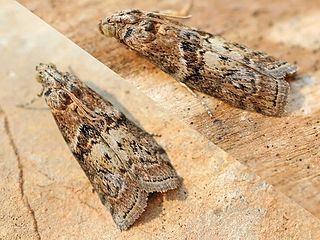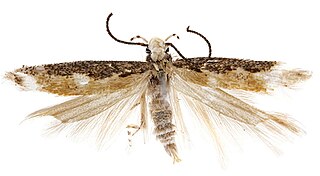
Caterpillars are the larval stage of members of the order Lepidoptera.

Nicotiana is a genus of herbaceous plants and shrubs in the family Solanaceae, that is indigenous to the Americas, Australia, Southwestern Africa and the South Pacific. Various Nicotiana species, commonly referred to as tobacco plants, are cultivated as ornamental garden plants. N. tabacum is grown worldwide for the cultivation of tobacco leaves used for manufacturing and producing tobacco products, including cigars, cigarillos, cigarettes, chewing tobacco, dipping tobacco, snuff, and snus.

The Tortricidae are a family of moths, commonly known as tortrix moths or leafroller moths, in the order Lepidoptera. This large family has over 11,000 species described, and is the sole member of the superfamily Tortricoidea, although the genus Heliocosma is sometimes placed within this superfamily. Many of these are economically important pests. Olethreutidae is a junior synonym. The typical resting posture is with the wings folded back, producing a rather rounded profile.

Gracillariidae is an important family of insects in the order Lepidoptera and the principal family of leaf miners that includes several economic, horticultural or recently invasive pest species such as the horse-chestnut leaf miner, Cameraria ohridella.

The Batrachedridae are a small family of tiny moths. These are small, slender moths which rest with their wings wrapped tightly around their bodies.

Pterolonchidae is a small family of very small moths in the superfamily Gelechioidea. There are species native to every continent except Australia and Antarctica.

The Thyatirinae, or false owlet moths, are a subfamily of the moth family Drepanidae with about 200 species described. Until recently, most classifications treated this group as a separate family called Thyatiridae.

Philobota stella is a moth of the family Oecophoridae. It is found in Australia, including Tasmania.

Philobota lysizona is a moth of the family Oecophoridae. It is found in Australia.

Philobota partitella is a moth of the family Oecophoridae. It is found in Australia.

Calymma is a monotypic moth genus of the family Erebidae erected by Jacob Hübner in 1823. Its single species, Calymma communimacula, was first described by Michael Denis and Ignaz Schiffermüller in 1775. It is found in central and southern Europe and from Turkey to Transcaucasia and the Middle East.

Eois is a genus of tropical moths in the family Geometridae. It was first described by Jacob Hübner in 1818. Caterpillars of Eois species are most commonly green with darker markings, but species with fully dark caterpillars also exist. They are specialized feeders associated with Piperaceae species, with sparse additional records on Chloranthaceae species. Adults are typically small, with diverse wing shape, color and patterning across the genus.

Philobota ellenella is a moth of the family Oecophoridae. It is known from the Australian Capital Territory, New South Wales and Victoria.

The Phycitinae are a subfamily of snout moths. Even though the Pyralidae subfamilies are all quite diverse, Phycitinae stand out even by standards of their family: with over 600 genera considered valid and more than 4000 species placed here at present, they unite up more than three-quarters of living snout moth diversity. Together with the closely related Epipaschiinae, they are apparently the most advanced lineage of snout moths.

Neopalpa donaldtrumpi is a moth species of the genus Neopalpa occurring in Southern California and Northern Mexico. It was described in 2017 by Iranian-Canadian scientist Vazrick Nazari. Known for its yellowish-white head scales being reminiscent of Donald Trump's hair, the moth was given its name because Nazari stated that he wanted "to bring wider public attention to the need to continue protecting fragile habitats in the US that still contain many undescribed species."

Ichneutica fibriata is a moth in the family Noctuidae. It is endemic to New Zealand. Specimens of this moth were first collected by Frederick Giles Gibbs. The species is similar in appearance to other species in the Ichneutica genus particularly I. eris but can be distinguished due to its larger size and more uniform light grey colour. I. fibriata also has a similar coloured thorax and head where as these two anatomical features may differ in colour shade in I. eris. Adults frequent alpine areas and are on the wing in November to January. The life history and the host species of the larvae of this species is unknown.
Lusterala is a monotypic, neotropical genus of tortix moths provisionally assigned to tribe Grapholitini of subfamily Olethreutinae, with Lusterala phaseolana as sole species.

Tingena aletis is a species of moth in the family Oecophoridae. It is endemic to New Zealand and has been collected in the vicinity of Arthur's Pass in the South Island. Adults are on the wing in January.


















